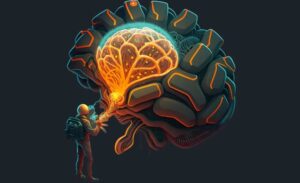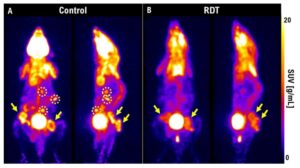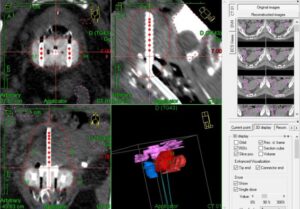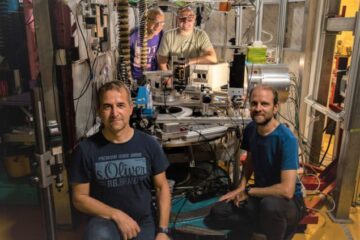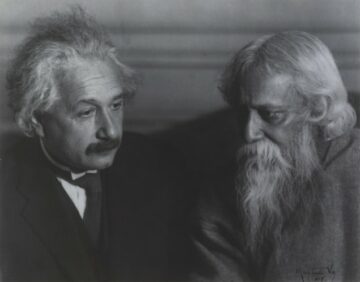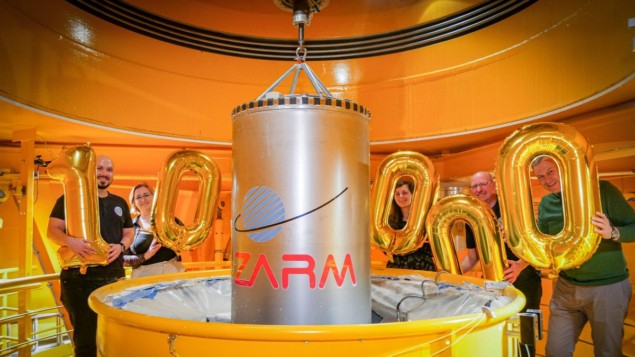
Humans have been sending things into space for nearly 70 years and one thing that we have learned is that the microgravity conditions on satellites and spacecraft can have important consequences for both living and non-living systems. As a result, space agencies and satellite makers are keen on testing things in low-gravity environments before sending them into space.
To avoid the extremely high cost of launching things into space to see how they behave, researchers use a remarkably simple technique to create low-gravity environments here on Earth. Entire experiments are dropped within special towers, where they experience near-weightlessness for several seconds. While this doesn’t sound like a very long time, it’s enough to understand the effects of low gravity on things that happen very quickly – such as chemical reactions.
One of the world’s leading drop tower labs is the Fallturm in Germany – and the facility is celebrating its 10,000th drop. Complete in 1990, the slender tower offers a free-fall distance of 110 m and is part of the Center of Applied Space Technology and Microgravity (ZARM) at the University of Bremen.
The milestone experiment focussed on artificial photosynthesis and was led by Katharina Brinkert of ZARM and the UK’s University of Warwick. The goal is to find a replacement for the bulky, unreliable and energy-hungry electrolysers that generate oxygen on the International Space Station (ISS). The experiment looks at how magnetism can be used to separate oxygen bubbles from water in weightlessness. “How can oxygen, hydrogen and other chemicals be produced sustainably in microgravity, and how can we benefit from this here on Earth? These are key questions to us,” explains Brinkert.
You can read more about Falturm and the drop here.
Radar disruption
Many in the auto industry believe that self-driving cars represent the future, but not all road users are convinced. While automated-driving systems are, in principle, more reliable that human drivers there are a plethora of technological and moral issues that need to be addressed. One challenge is the fact that a bad actor might seek to disrupt a self-driving car to commit a crime or an act of terrorism.
Now, a team in the US led by Duke University’s Miroslav Pajic and Tingjun Chen have created a system called MadRad, which shows exactly how such an attack could be done.
“Without knowing much about the targeted car’s radar system, we can make a fake vehicle appear out of nowhere or make an actual vehicle disappear in real-world experiments,” Pajic says.
You might be wondering why the researchers are building such a system, given that it could be used by people with bad intentions. “We’re not building these systems to hurt anyone, we’re demonstrating the existing problems with current radar systems to show that we need to fundamentally change how we design them,” Pajic explains.
The radar-spoofing system first determines a car’s radar parameters, which it does in about a quarter of a second. Then MadRad system sends out its own radar signals to fool the target’s radar.
You can read more about this terrifying system here.
- SEO Powered Content & PR Distribution. Get Amplified Today.
- PlatoData.Network Vertical Generative Ai. Empower Yourself. Access Here.
- PlatoAiStream. Web3 Intelligence. Knowledge Amplified. Access Here.
- PlatoESG. Carbon, CleanTech, Energy, Environment, Solar, Waste Management. Access Here.
- PlatoHealth. Biotech and Clinical Trials Intelligence. Access Here.
- Source: https://physicsworld.com/a/zarm-celebrates-dropping-its-10000th-experiment-madrad-fools-self-driving-cars/
- :is
- :not
- :where
- 10
- 110
- 70
- a
- About
- Act
- actual
- addressed
- After
- agencies
- All
- an
- and
- anyone
- appear
- applied
- ARE
- artificial
- AS
- At
- attack
- auto
- avoid
- Bad
- BE
- became
- been
- before
- believe
- benefit
- both
- Building
- but
- by
- called
- CAN
- car
- cars
- celebrates
- Celebrating
- challenge
- change
- chemical
- chemicals
- commit
- complete
- conditions
- Consequences
- convinced
- Cost
- could
- courtesy
- create
- created
- Crime
- Current
- demonstrating
- Design
- determines
- disappear
- Disrupt
- distance
- does
- Doesn’t
- done
- drivers
- Drop
- dropped
- Dropping
- Duke
- earth
- effects
- enough
- Entire
- environments
- exactly
- existing
- experience
- experiment
- experiments
- Explains
- extremely
- Facility
- fact
- fake
- Fall
- Find
- First
- focussed
- For
- from
- fundamentally
- future
- generate
- Germany
- given
- goal
- gravity
- happen
- Have
- here
- High
- How
- HTML
- HTTPS
- human
- Hurt
- hydrogen
- important
- in
- industry
- information
- intentions
- International
- international space station
- International Space Station (ISS)
- into
- ISS
- issue
- issues
- IT
- ITS
- jpg
- Keen
- Key
- Knowing
- Labs
- launching
- leading
- learned
- Led
- like
- living
- Long
- long time
- LOOKS
- Low
- Magnetism
- make
- Makers
- max-width
- might
- milestone
- moral
- more
- much
- nearly
- Need
- of
- Offers
- on
- ONE
- or
- Other
- out
- own
- Oxygen
- parameters
- part
- People
- Photosynthesis
- Physics
- Physics World
- plato
- Plato Data Intelligence
- PlatoData
- plethora
- principle
- problems
- Produced
- Quarter
- Questions
- quickly
- radar
- reactions
- Read
- real world
- reliable
- replacement
- represent
- researchers
- result
- road
- satellite
- satellites
- says
- Second
- seconds
- see
- Seek
- self-driving
- self-driving car
- sending
- sends
- separate
- several
- show
- Shows
- signals
- Simple
- Sound
- Space
- space station
- spacecraft
- special
- station
- such
- sustainably
- system
- Systems
- targeted
- team
- technique
- technological
- Technology
- terrifying
- Terrorism
- Testing
- that
- The
- The Future
- Them
- then
- There.
- These
- they
- thing
- things
- this
- thumbnail
- time
- to
- Tower
- true
- understand
- university
- us
- use
- used
- users
- vehicle
- very
- was
- Water
- we
- which
- while
- why
- with
- within
- wondering
- world
- world’s
- years
- zephyrnet




